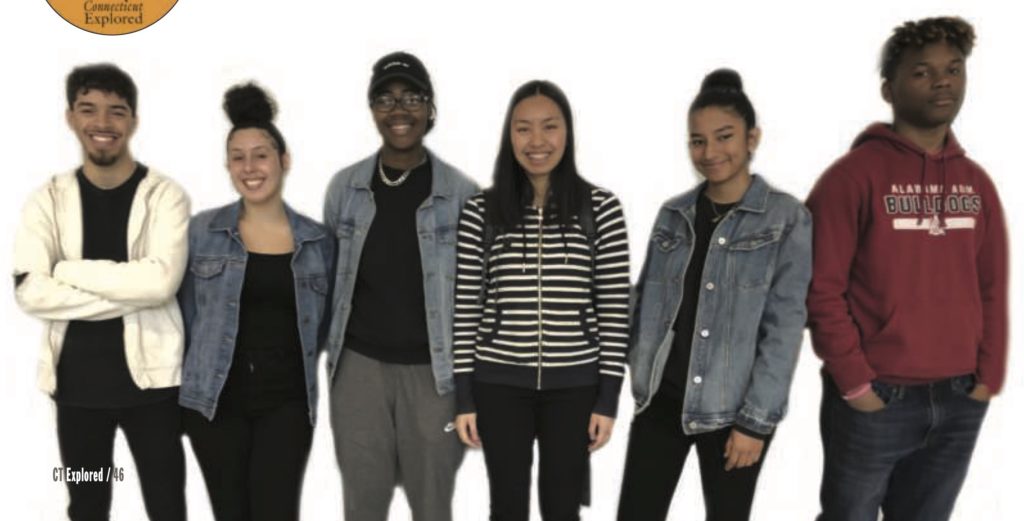
New Haven students who contributed to the Black, Indigenous, and Latinx Peoples’ History of New Haven map in its first year and who created the walking tours: (l to r) Angel Rovira, Kaleeah Ramos, E’moni Cotten, Darlaney Chanthinith, Flor Jimenez, and Dameon Dillard. Courtesy Nataliya Braginsky
By Jasmin Agosto and Nataliya Braginsky
(c) Connecticut Explored Inc., Fall 2022
Subscribe/Buy the Issue!
From Hartford to New Haven, in public libraries and public schools, with elders and teens, we are working to redefine what it means to make history. Who is the authority on history and knowledge production? Whose histories matter? How do these histories get shared accessibly? We recognize that history surrounds us, that the land and the people of this land, passed on and alive, hold all that has happened and will happen here. We are working with our communities to unearth, preserve, and share these histories.
High-School Students Uncovering New Haven’s Black, Indigenous, and Latinx History
In New Haven, high-school students have not only been uncovering the history of their city, they’ve been educating their community about it. This powerful work is taking place in the new African-American/Black and Puerto Rican/Latinx history course (created by Public Act 19-12; see page 26), a class whose very existence is a result of youth activism. Young people from throughout Connecticut—members of Students for Educational Justice, Hearing Youth Voices, Connecticut Students for a Dream, Citywide Youth Coalition, and the Connecticut Black and Brown Student Union—came together to demand that their histories be taught—and they won! In 2019 the Connecticut legislature passed a law mandating that every high school in the state offer a Black and Latinx history course. This law goes into effect in Fall 2022, but in New Haven we decided this course was long overdue and there was no reason to wait. For the last three years, students at Metropolitan Business Academy have been studying Black, Indigenous, and Latinx history and have been educating their peers and teachers about the legacy of these histories in New Haven.
The interactive map of New Haven’s Black, Indigenous, and Latinx history, created in 2019, came out of this work. It began with 40 students researching 40 sites. The students relied on primary sources to make sense of the history that surrounds us but that had been so little known. They learned about people, places, and events that brought New Haven and the city’s struggles for justice alive, histories that spanned hundreds of years. The many sites they researched helped us to better understand New Haven’s political, social, and cultural history.
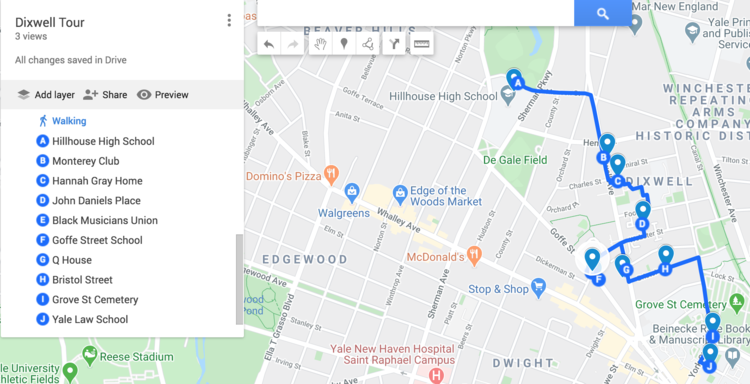
Screenshot from the Black, Indigenous, and Latinx Peoples’ History of New Haven Google map showing sites and themed walking tours researched and created by students of Nataliya Braginsky, Metropolitan Business Academy, New Haven, 2019 – 2021.
In January 2020 we invited fellow peers, teachers, and community members to join us in our classroom as students gave virtual tours of the sites they had researched. We transformed our classroom into a timeline of New Haven history, and students displayed their primary sources to help tell the stories they had unearthed. As E’moni Cotten shared in a recent conversation about the map project: “This project is really important because it allowed me as a student to become a historian and also an educator. [And it allowed] my teachers and other adults in the community to become students and learners.” In fact, several community members—social studies teachers and professors of history among them—approached me after attending the students’ tour to express how much they had learned and how inspired they were. That day remains one of my most memorable as a teacher. It wasn’t just that students were teaching their communities, they were doing it with creativity, with connection, and with the emotion that these histories warrant.
I vividly recall one student’s speaking about a remarkable but little-known site in his neighborhood in Fair Haven. He told a group of audience members about his years of playing basketball at Criscuolo Park and how now, having learned the site’s history, he gets chills when he’s there. He’d learned that Frederick Douglass spoke there on January 29, 1864 to the Connecticut 29th and 30th regiments of Black soldiers before they set off to fight for freedom in the Civil War. A monument stands in the park recognizing the Black soldiers, but there is no acknowledgement of Frederick Douglass’s presence in New Haven or his address to the soldiers. Now this history will live on through this student-created map project, which today has had nearly 34,000 views.
The site of Frederick Douglass’s speech in New Haven is but one of 80 now on the map, co-created by three cohorts of Metropolitan’s African American and Latinx History students. The map also inspired a project that has helped to bring New Haven history alive in another way—through audio. We approached New Haven’s International Festival of Arts and Ideas to propose the idea of New Haven students’ giving walking tours of their city. I worked with six students in Metropolitan’s first African American and Latinx history class to design two tours, one in the Hill neighborhood and the other in the Dixwell neighborhood. Students chose the sites they wanted to highlight and prepared to become tour guides in their city. Sadly, the pandemic arrived in New Haven, thwarting the possibility of in-person tours. With the support of many community members, including Donnell Durden and Tiffany Stewart of Aligning, together we created audio walking tours of these two neighborhoods. Led by the voices of Darlaney Chanthinith, E’moni Cotten, Dameon Dillard, Flor Jimenez, Kaleeah Ramos, and Angel Rovira, anyone can now walk the streets of New Haven, see the historic sites, and hear the many stories this city holds.
Artists and Elders are Hartford Changemakers
When it comes to the history of any city, much of our information comes from archives of material written overwhelmingly by white men with traditional education. We also know that in the United States our earliest documents are colonial and their primary authors are European settlers. If these are the voices at the foundation of our public archive, how do we alter perceptions as to what is seen as true and valuable history? How do we begin to cobble together, locate, preserve, and share the full histories of our cities to include those voices of indigenous, Black, Latinx and other systemically oppressed and marginalized peoples? Who gets to interpret and tell these stories? How does a public library and archive in the capital city of an early American settlement take responsibility for encouraging the next generation of history makers?
During Black History Month in 2016 the Hartford History Center at Hartford Public Library celebrated two dozen African American individuals in history who made an impact on the city of Hartford and beyond. The center posted photographs and short biographies on Facebook. Much of the information for the posts came from a reference collection of profiles that had been created by the City of Hartford to highlight important Black figures through the years. Research also included Hartford Courant and Hartford Times articles, photographs, and obituaries.
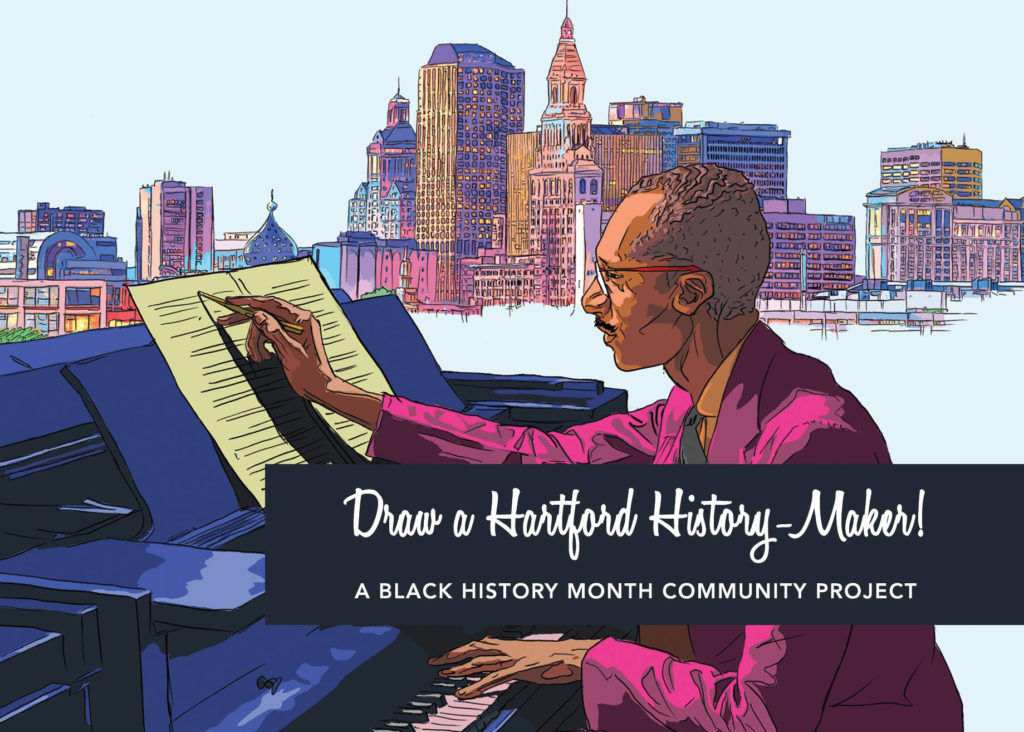
Postcard for Draw a Hartford History Maker with Joel Agosto’s artwork depicting musician-educator Warner Lawson. Hartford History Center, Hartford Public Library
We wanted to expand on this work further and engage a wider cross-section of community members. The center put out a call for artists of all ages and who work in different media to create portraits of these local heroes and heroines for a project we called Draw a Hartford History Maker. It culminated in an exhibition launched in February 2017. Staff received heartfelt responses from community members, some of whom shared that this was the first they’d learned about these individuals, and some shared that they saw people they had looked up to when growing up honored for the first time. Throughout the next few years, this exhibition was featured during Black History Month through social media postings and as an exhibition at the downtown library and branch libraries in both the North End and South End neighborhoods. It is still one of our most requested and used exhibitions and teaching tools.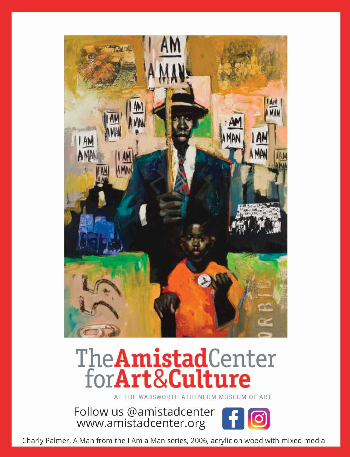
For summer 2020 the center paired up with the library’s programming department and its YOUmedia Hartford teen center to develop intergenerational programming. Through the Hartford Changemakers project, we sought to further expand access to the history of our Hartford History Makers and offer history-making tools to our community members. Although the COVID pandemic hit that year, the center was able to offer virtual arts-based programming and some outdoor, in-person programming to city residents. That spring, in anticipation of the summer program, the staff developed its evolving Hartford Changemakers online resource, which can be accessed through the Hartford Public Library’s website or by simply googling Hartford Changemakers. The resource now features more than 45 Black, Latinx, and indigenous people in Hartford history. It includes photographs, biographies in English and Spanish, and links to reference materials found in our archival collections and sources outside of our institution. The online resource is one of our most-used reference guides for teachers and professors looking to inspire their students to learn about local history and consider various career pathways. The complementary programming, which just completed its third summer, has offered six-week workshops facilitated by Hartford-based artists in mural making, storytelling, poetry, dance, documentary photography, public sculpture, mask making, community gardening, and family recipe creation. Projects produced by community members have been preserved in the Hartford History Center as history in the making.
In summer 2021 I was approached by longtime Northeast Hartford neighborhood resident, HPL board member, retired Hartford Fire Captain, and summer 2020 Hartford Changemakers program participant Steve Harris [see page 30]about creating a mural to honor the history of Black firefighters in the city of Hartford. We developed the project as part of the Hartford Changemakers summer program, bringing together elder members of the Phoenix Society of Hartford, an organization of Black firefighters, two young Hartford-based artists, Lindaluz Carrillo and Kayla Farrell, and a group of intergenerational Hartford residents. Together they learned about this history through the collections and oral histories of Phoenix Society members and created a visual representation that took up a large wall on the outside of the society’s building on Sanford and Windsor streets, a historically and contemporarily Black neighborhood.
The mural ended up being a tribute to Hartford’s first Black firefighter, William Henry Jaclynn, who was a volunteer with Engine Co. #7 on Sanford and Main streets through 1908, at which time he refused to be part of a department that didn’t allow him to sleep in the same quarters as his white peers. It took 40 more years for Black men to be recruited to the Hartford Fire Department. In 1966 Black firefighters founded the Phoenix Society of Hartford to develop mentorship and a generational support system for Black firefighters to survive, be recognized, and thrive in the department. It was an emotional and rewarding process for Phoenix Society members, including the late Cecil W. Alston, a 32-year career firefighter and a participating member of the project who passed away just months ago, in February 2022. This project confirmed how important it is to keep history alive and to keep making strides in challenging our histories to include the voices of as many of our residents as possible. And it is also through this process that we affirm how powerful art is as a storytelling tool. As Mr. Harris shared recently, “We are visual; we need to see it, feel it, connect to it.”
New Haven and Hartford in Conversation
On March 30, 2022 we were invited to bring our New Haven and Hartford projects into conversation with one another by the Jewett Center for Community Partnerships at Wesleyan University for their “We Make History” series. In this virtual conversation we brought together two former New Haven students, E’moni Cotten and Dameon Dillard, with Hartford Changemakers programming champions Steve Harris and Lindaluz Carrillo. The conversation was riveting. Not only did we get to share these exciting projects between two of Connecticut’s major cities, but we also heard deep reflections from students, artists, and elders telling stories that matter to them and co-creating history by doing so.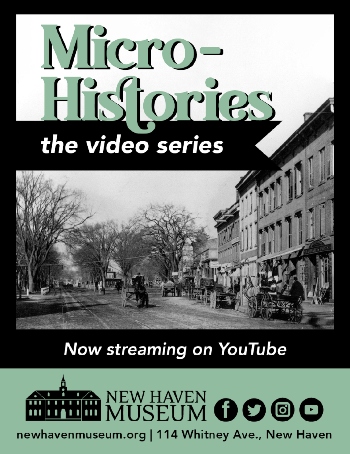
Framing this conversation and its stakes, Jasmin asked, “What happens when we become the historians, when we become the storytellers, when we take up our own streets and our own stories, and tell them and make them accessible to everybody in the community? What happens? What changes in our lives and the lives of our community members?” Our elders and our young people answered those questions in the most powerful ways.
Speaking directly to the youth on the panel, Mr. Harris said, “It is important for me to tell my story because when the history is told I want us to tell our history. I want us to talk about what our struggles were. I want us to tell our young brothers and sisters you can do this. I did this. You can do this.” Mr. Harris also reminded us, “If we want our history told, we need to talk to our elders. We need to talk to our elders, because we’re all here on borrowed time. Don’t let the opportunity go by and then when you finally decide to ask the question, that elder isn’t here to answer that question for you.”
This theme resonated among New Haven youth. E’moni, who talked about recording her grandparents, shared: “Me being the oldest of five siblings, doing this project lit the fire to educate the people around me. It also made me really cherish my elders. Ever since this project, I have the drive to know more about the people before me and just my roots. I think this project just got me more interested in where I come from and the power behind where I am right now. New Haven is my city, I live here, I’m from here, and that’s part of me. Now I feel more connected to the city, I feel more connected to my family, and just the people around me.”
As Mr. Harris said, this conversation around our projects “restored [his]faith” in future generations. He added, “I want you to realize the impact that not only you are having on your peers, but the impact that you’re having on folks like me.”
Dameon Dillard responded, “Mr. Harris, I appreciate you having faith in us.”
This conversation inspired us and deepened our resolve. We understand how critical it is for the people of our cities to uncover and tell their own stories. We also know that there must be institutional and financial support in order for these projects to come to life and to be sustained over time. It is through this understanding that we call for more institutional backing for strategic, community-based, intergenerational, cross-city, and creative curriculum and program development centering on the voices and expertise of young people, artists, and elders.
Jasmin Agosto and Nataliya Braginsky served on the advisory team for 20 for 20: Innovation in Connecticut History. Agosto is the education and community outreach manager at the Hartford History Center at Hartford Public Library. Braginsky was a high-school history and English teacher at Metropolitan Business Academy and a teacher-organizer with the Anti-Racist Teaching and Learning Collective.
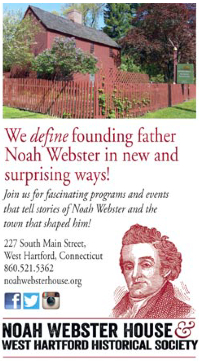 Explore!
Explore!
A Black, Indigenous, and Latinx Peoples’ History of New Haven
Interactive map and audio tours created by Nataliya Braginsky’s students
“We Make History” conversation via Wesleyan University’s Jewett Center for Community Partnerships
GO TO NEXT STORY
GO BACK TO FALL 2022 CONTENTS
